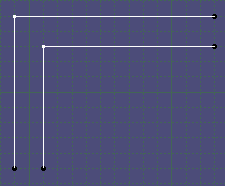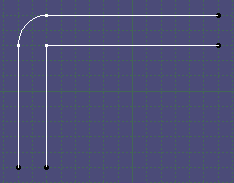Create the Parallel Curve
You can create a curve that is parallel to an existing curve at a specified offset distance.
Click Parallel Curve
 in the Wireframe toolbar (Curve Offsets sub-toolbar). in the Wireframe toolbar (Curve Offsets sub-toolbar).
The Parallel Curve Definition dialog box appears.
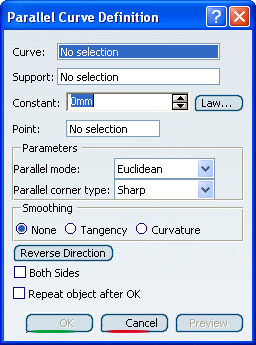
In the Curve box, select the reference curve to be offset. In the Support box, select the plane or surface on which
the reference curve lies. Specify the offset of the parallel curve either by:
- entering a value or using the graphic manipulator in the Constant box.
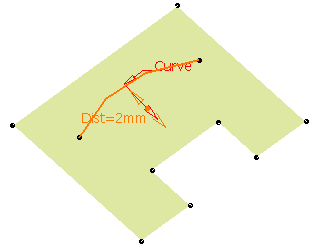
- selecting a point in the Point box (in both
Geodesic and Euclidean mode).
In that case, Constant is grayed.
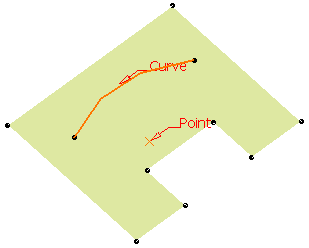
Choose the Parallel mode
to create the parallel curve.
- Euclidean: the distance between both curves will be
the shortest possible one, regardless of the support.
If you select this mode, you can choose to
offset the curve at a constant distance from the initial
element, or according to a law. In
this case, you need to select a law as defined in
Creating Law.
The law can be negative,
providing the curves are curvature continuous.
- Geodesic: the distance between both curves will be
the shortest possible one, taking the support curvature into
account. In this case, the offset always is constant to every point
on the curve and you do not need to select a corner type.
Select Parallel corner type
(useful for curves presenting sharp angles).
Click Preview.
The parallel curve is displayed on the support surface and normal
to the reference curve.
Click OK to create the parallel curve.
The curve (identified as Parallel.xxx) is added to
the specification tree.
Parallel curve defined by an constant offset value
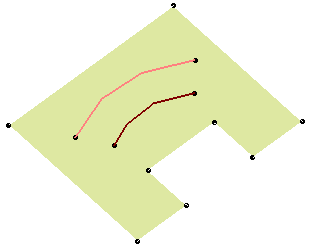
Parallel curve defined by a passing point


Smooth the Curve
You can smoothen parallel curves by defining continuity.

- You can smooth the curve by selecting either:
- None: deactivates the smoothing result
With a support surface:
- Tangency: enhances the current
continuity to tangent continuity
- Curvature: enhances the current continuity to curvature
continuity
You can specify the maximum
deviation for G1 or G2 smoothing by entering a value or using the
spinners.
In the case of an Euclidian parallel
curve, only small discontinuities are smoothed, especially discontinuities
that are introduced during the parallel operation.
Moreover, a topology simplification
is automatically performed for G2 vertices: cells with a curvature
continuity are merged.
Without support surface:
- 3D Smoothing: the smoothing is
performed without specifying any support surface. As a consequence, the resulting smoothed curve has a better continuity
quality and is not exactly laid down on the surface. As a consequence, you may need to activate the
Tolerant laydown
option. Refer to
Customizing section: General. This option is available if you previously select the Tangency or
Curvature smoothing type.
With 3D smoothing option selected

With 3D smoothing option cleared
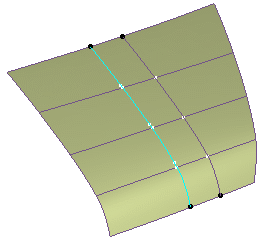
- None: deactivates the smoothing result

Use a Law
You can define a law to create parallel curves.
Click Law... to
display the Law Definition dialog box. In this case, you need to
select a law as defined in Creating Law.
The 2D viewer enables you to preview the law evolution
before applying it.
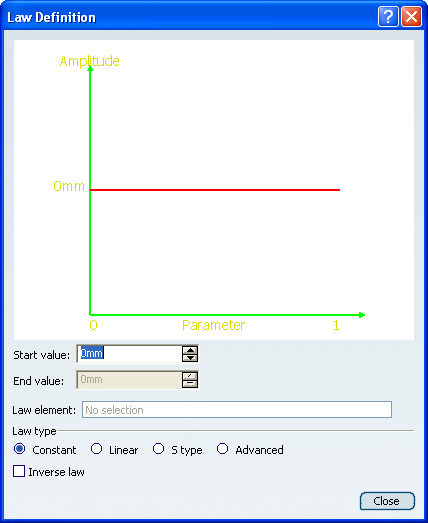
The Law Viewer allows you to:
-
visualize the law evolution and the maximum and minimum
values,
-
navigate into the viewer by panning and zooming (using
the mouse),
-
trace the law coordinates by using the manipulator,
-
change the viewer size by changing the panel size
-
reframe on by using the viewer contextual menu
-
change the law evaluation step by using the viewer
contextual menu (from 0.1 (10 evaluations) to 0.001 (1000
evaluations)).
Enter a Start value and
an End value. Choose the law type.
Four law types are available:
-
Constant: a regular law, only one value is
needed.
-
Linear: a linear progression law between the
Start and End indicated values.
-
S type: an S-shaped law between the two
indicated values. For this type, you need to define a second value. The
distance will vary between these two values.
-
Advanced: allowing to select a Law element
as defined in Creating Law.
Select the Inverse law check box to reverse the law as
defined using the above options.
Click Close to return
to the Parallel Curve Definition dialog box.
|
![]()

 With 3D smoothing option cleared
With 3D smoothing option cleared
![]()



